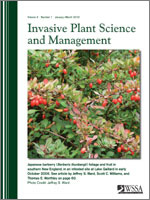Japanese knotweed (JK) is one of the most aggressive invasive plants known in the U.K., where its biology has been well-studied. It was introduced into Canada around 1900, but only recently has it become a serious concern in the province of British Columbia (BC). Climatic conditions, including annual degree days and mean-annual minimum temperatures at knotweed sites in British Columbia were modeled in BioSIM, using weather normals and long-term daily weather data, and compared to published thresholds (degree day = 2,505 DD, minimum temperature = −30.2 C, base temperature 0 C ). The degree-day threshold was more limiting to JK in British Columbia than mean-minimum temperature (12.3% of province habitat was suitable for JK based on degree days compared with 26% for mean-minimum temperature). A new annual-precipitation threshold of 735 mm/year based on 95% of known knotweed sites in BC was identified. The best-fit logistic regression model included degree days and annual precipitation and predicted knotweed presence/absence with over 97% efficiency. Existing knotweed sites occupy just over half of the suitable habitat in BC, indicating there are still significant areas to be invaded. The limiting threshold for knotweed was reversed in Southern Ontario with between 35 to 53% of the habitat suitable based on minimum temperatures, whereas degree-day accumulations and annual precipitation were not limiting. Warmer temperatures from 2000 to 2008 resulted in an increase to 53% of the habitat in Southern Ontario being suitable for knotweed, compared to 35% when 1971 to 2000 weather normals were used. Different climatic thresholds among provinces might result in selection for different invasive knotweed genotypes. This could influence the success of biological control agents because of differential host suitability of knotweed genotypes. Habitat suitability maps generated will enable better targeting of knotweed surveys based on the risk of knotweed establishment.
Nomenclature: Japanese knotweed, Polygonum cuspidatum Sieb. et Zucc. [syn. Fallopia japonica (Houtt.) Ronse Decraene var. japonica]; Giant knotweed, Polygonum sachalinense F. Schmidt ex Maxim.[syn. Fallopia sachalinensis (F. Schmidt) Ronse Decraene]; Bohemian knotweed, Polygonum ×bohemicum (J. Chrtek & Chrtková) Zika & Jacobson [cuspidatum × sachalinense] [syn. Fallopia × bohemica (Chrtek and Chrtková) J. P. Bailey.].





